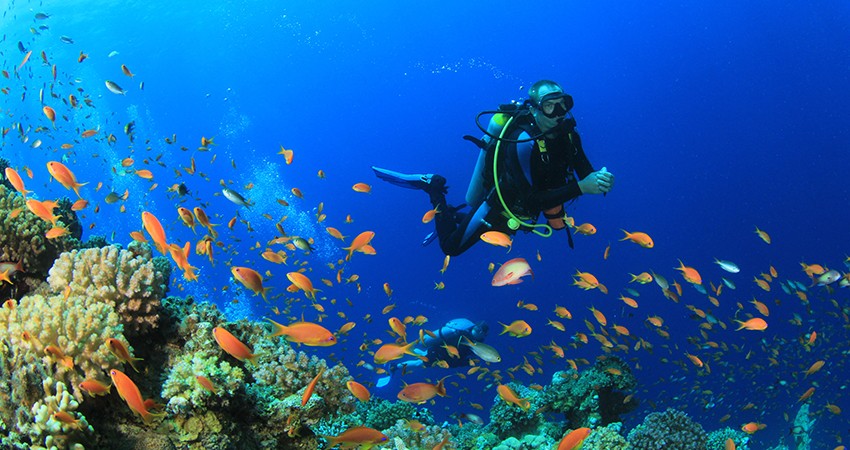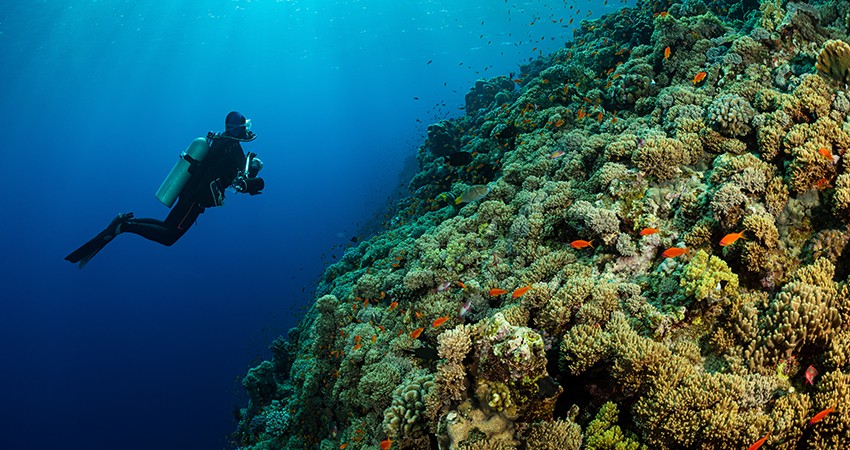Diving Sites in Port Blair







If you want to feel like flying underwater, then dive in a current! In the PADI Drift Diver course, our experienced instructor will teach you drift diving tips. You will be practising buoyancy control, navigation, use of surface signalling equipment, and buddy communication.
Drift diving is all about gliding with currents, feeling the rush of flying underwater, and watching fish moving up the current effortlessly. There will be one dive in this course and the duration of the entire experience will be around three hours. You will be exposing yourself to the techniques and procedures for drift diving.
Download Medical FormIn this Course, you will Learn How to:
- Try drift diving with an instructor
- Feel confident diving in a current
- Learn about aquatic currents - causes and effects
- Use surface signalling equipment
- Stay close to your buddy
- Make entries and descents in a current
Some of the Topics Covered in this Course will Include the following:
- Planning, Organisation, problems and hazards of drift diving
- Special equipment (floats, lines, reels)
- Proper procedures for buoyancy control, navigation, and communication
Go With the Flow – Join Drift Diving Now
Why Take the PADI Drift Diving Course?
Diving in a current can be both exhilarating and relaxing. You may slowly glide over a reef or move very speedily over an underwater landscape that it may feel like flying. This course will teach you the skills that you will require to confidently go with the flow.
Independent Study
PADI eLearning - You can fit scuba diving lessons into your hectic schedule easily with online learning. One can complete the independent study part of this diving course at their convenience. You can work at your own pace, online or offline, using a mobile device or a computer. Talk to the instructor for in-water training or whenever there is some doubt.
eLearning time commitment: 2-4 hours
With your Instructor
This will be done at the dive centre. There will be 2 dives in a current wherein you will practice buoyancy control, navigation, and buddy communication. You will be practising using a delayed surface marker buoy (DSMB), float, line, reel, or other drift diving safety equipment.
- Prerequisites: PADI (Junior) Open Water Diver (or qualifying entry-level certification)
- Total time commitment: 1-2 days
- Minimum age: 12 years or older
Medical Requirements
A minimum level of health and fitness is required for scuba diving. In case you are suffering from any chronic health condition, or taking certain medications and/or had surgery recently, you will have to get written approval from a physician before diving. In order to avoid any confusion, you can simply download and review the Diver Medical Form to make sure that you will not require approval from a physician to dive.
You should not ask your instructor, dive master, or dive shop staff for medical advice as they are not physicians. Only medical professionals can give medical clearance to dive if you do not have a minimum level of health and fitness.
Prerequisites & Minimum Age
- Minimum Age: 12 years
- Course prerequisites: (Junior) Open Water Diver or equivalent certification
Drift diving is all about gliding with the currents, watching the big pelagic fish move up current, and feeling the adrenaline rush of flying under the water. During the PADI Drift Diver course, you will be going on two open-water scuba dives.
The following topics will be covered in this diving program:
- Planning, Organisation, problems and hazards of drift diving
- Special equipment (floats, lines, reels)
- Proper procedures for buoyancy-control, navigation, and communication
- Site selection and an overview of aquatic currents causes and effects
- Techniques for staying close to a buddy or together as a group
Other Costs & Equipment
PADI Drift Diver course comprises knowledge development as well as in-water training for certification. Only the knowledge development part is covered in the cost when you purchase PADI eLearning online. There is an additional cost involved in the certification with the PADI instructor. The cost varies on the basis of the class size, environment, and whether or not you need to rent equipment.
You can contact Dive Andaman, a 5-star PADI center in Havelock Island (Swaraj Dweep), for more information and pricing. Along with the scuba equipment, you will also need various surface marker buoys (SMB) and floats with lines and reels. No matter where you dive, an SMB is important safety equipment. It is recommended that you buy one prior to your course so that you can practise using it. This way, you will become familiar with its working.
Time Commitment
- PADI eLearning: 2-4 hours
- Entire course: 1-2 days
System requirements
The online courses of PADI work on the browsers listed below: Ensure that your browser is updated to have the best experience.
- Chrome
- Safari
- Edge
- Firefox
You can also study at a location that has no internet access. Just use the PADI Training app to download course content and study offline. You can download the content in small sections with a total file size of around 177 MB. You can upload your progress when you get back online. This will help you in resuming your training right where you left off. The app is available for Android as well as Apple iOS devices. Devices should not be more than three models old and updated with the latest Operating System (OS).
After PADI Drift Diver Course
The first dive of the PADI Drift Diver Specialty course may be counted toward your Advanced Open Water Diver certification. Only two per cent of divers are able to achieve this elite rating. It is one step closer to becoming a PADI Master Scuba Diver. If you are in the Andaman Islands and are willing to enrol in the PADI Drift Diver course, then trust none other than the best–Dive Andaman. Located in Havelock Island (Swaraj Dweep), our 5-star PADI center is a renowned dive shop that offers all kinds of diving programs designed for beginners as well as experienced, along with recreational dives as well. Except for Taj Exotica Resort & Spa and Barefoot, we will provide you pick-up and drop-off facility as well.
Frequently Asked Questions
-
Q. 1 : What is the PADI Drift Diver course?The PADI Drift Diver course is a specialty scuba diving certification that teaches divers how to safely and comfortably navigate and enjoy drift dives. The course covers techniques for diving in currents, how to use specialized equipment such as drift lines, and how to plan and execute drift dives.
-
Q. 2 : Where can I take the PADI Drift Diver course in India?The PADI Drift Diver course is offered at many dive centers and resorts throughout India, including popular diving destinations such as the Andaman Islands, Lakshadweep Islands, Goa, and Pondicherry.
-
Q. 3 : What are the prerequisites for the PADI Drift Diver course?To take the PADI Drift Diver course, you must have a PADI Open Water Diver or equivalent certification, be at least 12 years old, and have completed at least 20 dives.
-
Q. 4 : How long does the PADI Drift Diver course take to complete?The PADI Drift Diver course typically takes one or two days to complete, depending on the dive center and the schedule of the student.
-
Q. 5 : What topics are covered in the PADI Drift Diver course?The PADI Drift Diver course covers topics such as the effects of currents on divers, how to plan and execute drift dives, techniques for using drift lines and other equipment, and how to handle potential hazards associated with drift diving.
-
Q. 6 : What equipment do I need to take for the PADI Drift Diver course?You will need basic scuba diving equipment, including a wetsuit, fins, mask, regulator, and BCD, as well as a dive computer and a surface signaling device. Some dive centers may provide specialized equipment such as drift lines.
-
Q. 7 : How much does the PADI Drift Diver course cost in India?The cost of the PADI Drift Diver course can vary depending on the dive center and location, but it typically ranges from 10,000 to 20,000 Indian rupees.
-
Q. 8 : Can I take the PADI Drift Diver course if I have a medical condition?If you have a medical condition, you should consult with a doctor before taking the PADI Drift Diver course. You may need to obtain medical clearance from a doctor to ensure that it is safe for you to scuba dive.
-
Q. 9 : What are the benefits of taking the PADI Drift Diver course?The PADI Drift Diver course teaches divers how to safely and comfortably navigate and enjoy drift dives, which are some of the most exciting and rewarding types of diving. It can also improve your diving skills and confidence, and open up new opportunities for diving in a variety of locations around the world.
-
Q. 10 : What are some popular dive sites for drift diving in India?Some popular dive sites for drift diving in India include the currents of the Andaman Islands, the coral reefs of Lakshadweep, the shipwrecks off the coast of Goa, and the marine life-rich waters of Pondicherry.
-
Q. 11 : What is the certification process for the PADI Drift Diver course?To obtain your PADI Drift Diver certification, you must complete the course requirements, including classroom sessions, pool training, and at least two open water dives. You will also need to pass a final exam and demonstrate proficiency in the skills covered in the course. Once you have completed these requirements, you will receive your PADI Drift Diver certification card.
-
Q. 12 : What skills will I learn in the PADI Drift Diver course?During the course, you will learn how to plan and execute drift dives, including how to select a dive site, assess the current and weather conditions, and plan the dive profile. You will also learn how to use specialized equipment such as drift lines to maintain your position and control your descent and ascent in the water. You will also learn how to handle potential hazards associated with drift diving, such as getting separated from your dive buddy or encountering unexpected currents.
-
Q. 13 : What is the diving experience like in India?
India offers a diverse range of diving experiences, from coral reefs and shipwrecks to colorful marine life and stunning underwater landscapes. The Andaman Islands and Lakshadweep are known for their crystal-clear waters and rich marine biodiversity, while Goa and Pondicherry offer opportunities to explore shipwrecks and unique underwater topographies. Diving in India can be a rewarding and exciting experience, with many dive sites offering ideal conditions for drift diving.
-
Q. 14 : Is the PADI Drift Diver course difficult?The PADI Drift Diver course can be challenging, as it involves learning new techniques and skills for diving in currents. However, the course is designed to be accessible to divers with a range of experience levels, and with the guidance of a certified PADI instructor, you should be able to master the necessary skills and complete the course successfully.
-
Q. 15 : What are the safety considerations for drift diving?Drift diving can be safe and enjoyable with proper planning and execution. Some safety considerations to keep in mind include checking the weather and current conditions before diving, using specialized equipment such as drift lines to maintain your position and control your descent and ascent, staying close to your dive buddy, and maintaining constant communication throughout the dive.
-
Q. 16 : Can I take the PADI Drift Diver course if I have never done a drift dive before?Yes, the PADI Drift Diver course is designed for divers of all experience levels, including those who have never done a drift dive before. The course will teach you the skills and techniques necessary to safely and comfortably navigate and enjoy drift dives.
-
Q. 17 : How can I prepare for the PADI Drift Diver course?To prepare for the PADI Drift Diver course, you can review the course materials and study the techniques and skills covered in the course. You can also practice your diving skills, including buoyancy control and navigation, to build confidence and improve your diving abilities. Additionally, it is recommended to stay in good physical condition and get plenty of rest before starting the course.
Diving Sites in Port Blair
Diving Sites in Havelock Island
Diving Sites in Neil Island
Talk to our Scuba Diving Expert
X